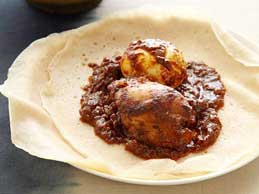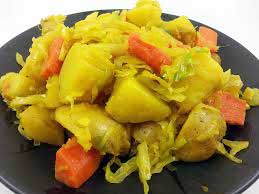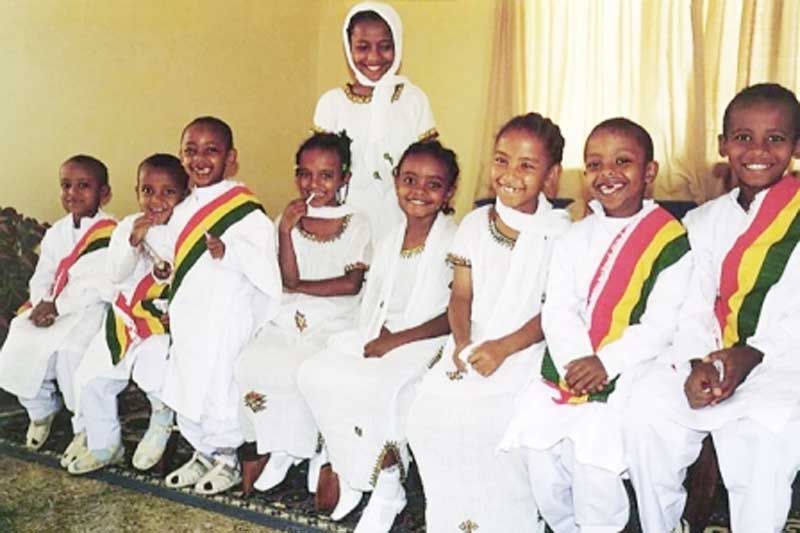Jeff Green | Dec 16, 2015
Christmas traditions in Ethiopia are distinct, because Ethiopia has a unique Christian heritage, going back to the very beginnings of the religion. The traditions have remained intact partly because Ethiopia has never been colonized successfully, so European Christmas traditions have never taken hold.
There a reference in the New Testament to the conversion of an Ethiopian court official in the first Century AD by Philip the Evangelist, and Christianity certainly had a presence in East Africa over the next few hundred years.
In the beginning of the 4th Century, two young brothers from a Christian family, Frumuntus and Edesius, were traveling from what is now Lebanon on a ship with their uncle. At a Red Sea port, the ship was attacked and everyone on board was massacred, save for the two boys. They were made slaves to the king of a country called Axum, in the vicinity of what has become Ethiopia, and gained positions of trust over time. They were freed just before the king died. Instead of leaving, they were prevailed upon by the queen to help educate Ezana, the young heir to the throne. Frumentius made a trip with his brother to Alexandria, where he prevailed on Athanasius, patriarch of Alexandria, to send a bishop and some priests as missionaries to Ethiopia. Athanasius decided to consecrate Frumentius and send him back instead.
Frumentius returned, baptized the young king, and established the Ethiopian church. Ethopia became either the first or second country in the world to adopt Christianity as its state religion, sometime between 328 and 346 AD. Frumuntus was sanctified for his efforts. The Ethiopian church later split with the church in Alexandria over theological differences.
The Tewahedo Church has 40 to 45 million followers and is the largest church in Ethiopia. About 60% of the population of 96 million are Christians. The Tewahedo Church follows the Julian calendar, celebrating the birth of Christ at the Feast of Ganna on January 7 each year.
Strict adherents of the church precede Ganna with a 40- day fast, so they have much to celebrate on January 7, although many only fast for one day, on Christmas Eve, January 6.
The rules of fasting, according to Ethiopianorthodox.org, are as follows: “Fast generally implies one meal a day to be taken either in the evening or after 2.45 p.m. with total abstention from meat, fats, eggs and dairy products. Instead they use cereals, vegetables and other type of food devoid of fats. Smoking is a breach of the fast.”
There are 250 fast days in the Tewahedo calendar, although only 180 are for everyone. The other 70 are only for clergy to follow. Among fast days there are not only the days of Lent, but Wednesdays and Fridays as well.
Tewahedo adherents also like to feast. There are nine major feasts of the Lord and nine minor ones, as well as 33 feasts of Mary. All of that makes for feasting or fasting about two-thirds of the time.
The number and character of fast/feast days in the calendar is reflected in Ethiopian food traditions. Since for over 1600 years they have had 180 one-meal days a year with no meat, fat, eggs and dairy, Ethiopians have developed a pretty tasty and nutritious vegan cuisine. They also make the most of meat, dairy and eggs in the dishes that are prepared for feasts.
Christmas Day (which is called Ganna, meaning birth) in the Tewahedo Church begins on January 7 at 4:00 in the morning - almost three hours before dawn. People dress all in white, and in rural areas many still wear a traditional garment, called a Shamma, on Christmas Day.
Tewahedo churches are circular, as are most of the rural houses. Some of the ancient churches, which are built entirely of stone, are still in existence in the country. The churches are set up in three concentric circles. The choir takes up the outer circle; the congregants are in the middle. On Christmas Day each congregant is given a lit candle and they walk in procession three times around the church before entering the middle circle to find a place to stand during the service. There are no seats in the church, and the men and women stand apart. At the center of the church is the inner circle where the priests, who are dressed in red and white, conduct the holy communion.
The Christmas mass lasts for three hours or more, and is followed by a full day of feasting and celebration.
The game of Ganna, a field game played with a wooden stick, called a Yeferas Suk, and a wooden or leather ball, is played by men and boys. There are two teams, and the size of the field is determined by the amount of flat land that is available to play on. It can be as long as a kilometre or more. The game is something like field hockey, and can be quite dangerous. The ball can only be picked up off the ground using the stick and transferred to the player's hand. It is tossed in the air and then hit with the stick, but during that process opposing players can either try to grab the ball, risking injury to their hand, or they can kick the player trying to hit the ball, risking injury to both players. Goals are scored when the ball passes a pre-set goal line.
A detailed description of the game, and its variations, can be found at the website gamesmuseum.uwaterloo.ca. The site includes the following cautionary explanation about Ganna.
“Ganna is played only in the afternoon and it lasts until dusk. It often ends peacefully. But on account of its roughness and disorderliness, heads sometimes are smashed, legs and hands broken or dislocated, cheeks torn, eyes lost and so on. However, in the game of Ganna there is no compensation whatsoever for any damage done to a player during the game because it is understood that no player does any harm to his adversaries deliberately.”
The festive season is not over at the end of Christmas Day. Twelve days later on January 19, a three-day feast called Timkat, celebrating the baptism of Jesus Christ, is celebrated. Timkat is marked by feasting and special songs.
Two of the major Christmas traditions that are ubiquitous across geographic boundaries in other parts of the world, the Christmas tree and gift-giving, have never taken hold in Ethiopia.
Before looking in some detail at Ethiopian Christmas food, I should note that, even though this article celebrates the unique Ethiopian religion and culture over the centuries, it is impossible to avoid certain realities about what has gone on in the country since it was formally established as a nation under Emperor Meneluk II in the 1890s.
Among the historical factors were wars with Italy, including an occupation between 1935 and 1941, and the influence, both good and bad, of Ras Tafari, who became Emperor Haile Selassie, and was at the center of Ethiopian politics for 60 years until 1974. At that time the Marxist-Leninist Dergue regime under Mengitsu was established and lasted 15 years. The annexation, secession and a subsequent border war with Eritrea was an economic and humanitarian disaster, and the serious impact of drought on the agricultural economy has left Ethiopia an economic disaster. Forty-four million Ethiopians live under the poverty line, and 12 million are chronically or periodically food insecure. 1.3 million Ethiopians are living with HIV or AIDS.
On the brighter side, the economy of Ethiopia has been growing and there is a substantial amount of land that could be turned to agriculture. Coffee and other exports also show some promise as a greater source of revenue. Political stability and economic and technological reform are helping turn Ethiopia's economy around. Growth has been robust over the last 10 years and poverty rates have been falling.
Farms in Ethiopia are typically plots of one hectare or even less, and one aspect of the economy that has not changed is the dependency of the rural farming population on a sufficient rainy season each year.
Recipes
Any major city in the world includes a number of thriving Ethiopian restaurants, invariably run by Ethiopian migrants.
The food in these restaurants is based on the kind of meals that Ethiopians consume daily and on feast days. There is a wide variety of meat, vegetable, and pulse-based dishes, all served on top of Injera, which functions as the grain base of the meal, the plate and even the cutlery. The amount of meat dishes served on the Injera are markers of wealth, honor, and feast days,
Since Injera is made with Teff, a tiny grain that happens to be gluten-free, and many traditional Ethiopian dishes are vegetarian, a traditional Ethiopian feast can satisfy the needs of any number of specialty diets. Vegans and Paleos, spice lovers and super tasters alike can enjoy an intimate shared meal.
It all starts with Injera, which means it can all start a day or three before the feast. Injera is a kind of hybrid between a bread and a pancake, and it is made using Teff flour, made of ground up Teff seeds. Teff seeds are tiny, 3000 to a gram, and the Teff grasses are native to Ehtiopia and Eritrea. Teff flour is available at Tara Foods and Bulk Barn in Kingston and at Foodsmiths in Perth.
Injera is a fermented pancake, and there are a number of ways to accomplish the effect of making these soft, spongy, slightly sour pancakes that are used to wrap up spicy Ethiopean dishes.
In North America it is common to combine Teff with wheat flours, and to add rising agents such as yeast or baking powder. There are also those who like to make a starter in the manner of a sourdough starter.
For our purposes I have included a simple recipe, using Teff and all purpose flour. While it is not the way Teff is made in Ethiopia, it has a better chance of being made successfully by beginners like us.
INJERA - start with a 50/50 mix of Teff and all purpose flour (feel free to substitute gluten-free flours or whole wheat flour.)
Toss 1 cup Teff flour in the bottom of the bowl, and mix with whatever other flour you are using for a total of two cups. Add 2-1/2 cups of water and mix together. Add a pinch of salt. Now you can either add a teaspoon of bread yeast or not, depending on whether you trust the Teff flour and wild yeast or not.
(The other option, which I will follow, is to do a half batch each way, just to be sure)
Mix until the batter is smooth. It should be quite thin. Cover with a cloth and let sit for one to three days. It can be used after one day, but the longer it sits the more it will have the distinctive sour flavor that sets off the spicy dishes it is served with. When ready, the mixture should be bubbly, and there may be a layer of water on top.
Mix it all together very well, using a blender if necessary to make a thin, pancake-like batter. Pour a thin stream of batter over a hot, 8-inch or more, non-stick or very lightly greased cast iron pan and shake the pan to spread the batter around the pan. There should be more batter in the pan than for a french crêpe but less than a standard pancake. Let sit in pan over medium high heat until bubbles form on the surface and the edges start to solidify. Turn down the heat, cover with a pot lid, and leave for 45 seconds, until the top of the Injera is steamed. Do not turn the Injera. At this point you can remove it from the pan to a plate. Keep cooking as you would crêpes, if necessary placing parchment or wax paper between each one so they do not stick together.
They are either served flat, with other dishes piled on top, or rolled up on the side to mop up the other dishes.
There are dozens of recipes for Ethopian dishes that are all served with Injera. Many of them are spiced with sliced banana or Jalapeno peppers and Berbero spice mix.
RED BERBERO SPICE can be made using readily available spices. Here is an easy recipe.
Mix 1/2 teaspoon ground fenugreek, 1/2 cup dried chiles, 1/4 cup paprika, 1 teaspoon each of salt, ground ginger, onion powder, 1/2 teaspoon each of ground cardamon, coriander, 1/4 teaspoon each of ground nutmeg and garlic powder, and 1/8 teaspoon each of ground cloves, cinnamon, and allspice.
Mix all the ingredients together thoroughly and store in an airtight jar.
Now we are ready to cook.
 DORO WOT (WAT)
DORO WOT (WAT)
This is one of the main Christmas dishes.
2 pounds skinless bone-in chicken thighs (about 8)
Juice of 1 lemon
Pinch Kosher salt
Tablespoon minced ginger
Tablespoon tomato paste
4 large eggs
1-1/4 cups chicken stock
2 large onions (finely diced)
1 tablespoon minced garlic
Berbere
Butter or Niter Kibbeh* (Ethiopian spiced butter)
Directions -
Toss chicken with lemon juice and 1 teaspoon kosher salt and leave stand at room temperature for 30 minutes.
Hard boil the six eggs. Cool, peel and set aside.
Put onions in large pan over medium/low heat and cook them, stirring constantly for ten minutes (note you did not oil the pan). The onions are cooked until the moisture is drawn from them. Add 1/6 pound of butter, 1/4 cup of Berbere, garlic, ginger, tomato paste and cook for one minute. Add the chicken and toss to coat with the butter mixture. Add the stock, bring to a simmer, cover, reduce heat to low and cook at a gentle simmer for 40 minutes. Remove the lid, increase the heat to medium and simmer until the liquid is reduced and the sauce is thick.
Remove the pan from the heat and add the eggs. Cover and let rest for five minutes. Place chicken on plates or Injera and serve.
A similar dish is made using stewing beef - Key Wot - although not usually with eggs.
Here is a vegetable dish
 TIKIL GOMEN (cabbage, carrots and potatoes)
TIKIL GOMEN (cabbage, carrots and potatoes)
1/2 cup canola oil
1-1/2 medium, yellow onions, thinly sliced
3 large carrots, peeled thinly sliced
2 white potatoes, peeled, cut in 1-inch cubes
1 tbsp crushed fresh garlic
1 tsp pureéd ginger
1/4 tsp each: turmeric, salt, black pepper
1 cup water
8 to 10 cups chopped, cored green cabbage
1 Jalapeno, chopped with seeds
In large saucepan, heat oil over medium. Add onion. Cook, stirring, 4 minutes. Add carrots. Cook, stirring, 4 minutes. Add potatoes. Cover; Cook 5 minutes. Add garlic, ginger, turmeric, salt and pepper. Cook, stirring, 1 minute. Add water. Cook, stirring, 3 minutes. Add cabbage and jalapeno. Cook, stirring, 2 minutes. Cover and cook, stirring occasionally, until vegetables are soft, about 5 to 8 minutes. (Don’t let it burn.)
Finally, here is a berbere spiced pulse dish, an Ethiopian Dal.
YEMISIR WOT (Berbere lentils)
3/4 cup canola oil
1-1/2 medium yellow onions, finely chopped
1/2 cup berbere spice blend, or to taste
1 tbsp puréed fresh ginger
2 tsp garlic crushed garlic
1 cup dried red lentils, washed
3 cups water + more if needed
1/2 tsp sea salt, or to taste
In medium saucepan, heat oil over medium. Add onions. Cook, stirring, 8 minutes. Stir in berbere, ginger and garlic. Cook, stirring, 2 minutes. Add lentils. Cook, stirring, 1 minute. Add 3 cups water. Bring to boil over high heat. Reduce heat to medium-low. Simmer, stirring often and adding water if needed, until lentils disintegrate and mixture is a thick stew, about 30 minutes.
For a recipe fo Niter Kibbe go to Food.com and type Niter Kibbeh in the search engine on the site.
More Stories
- Sticker Shock - EV Charging Station To Cost North Frontenac Township
- 30th Anniversary Verona Car Show
- The Forgotten Comfort Veg - Eggplant
- MERA Stage Comes Alive This Fall
- North Frontenac Council Report - August 27
- Addington Highlands Council Report - September 2
- Here's Grief - Have You Met
- Burn Ban Off in North Frontenac, Addington Highlands - Reduced to Level One in South and Central Frontenac
- The Resurgent Sharbot Lake County Inn and Crossing Pub
- Towards Then End of Trail

